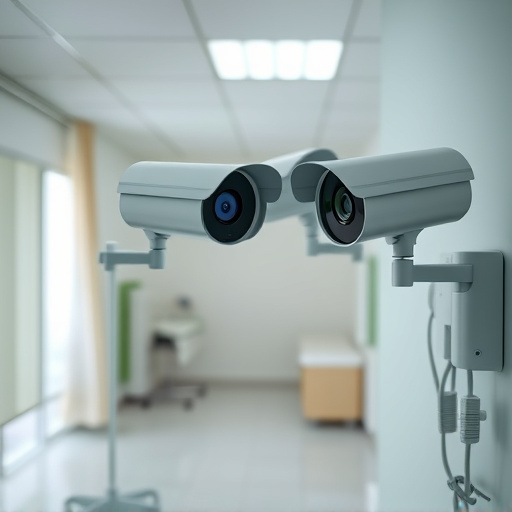In today's digital era, cameras for nursing homes have become essential tools for senior care, addressing an aging population's challenges. They offer continuous monitoring, enhancing safety and quality of life for residents through real-time data analysis and video analytics. Surveillance, thermal, and night vision cameras strategically placed in common areas, corridors, and rooms facilitate swift emergency responses, promote security, and detect falls. However, implementing these systems raises privacy concerns, requiring informed consent from residents and families, clear data storage guidelines, and compliance with data protection regulations to balance enhanced care with respect for personal autonomy.
In today’s digital age, monitoring systems for seniors have become indispensable tools in healthcare, particularly within nursing homes. “Understanding the Need for Monitoring Systems in Senior Care” explores the growing importance of these systems for safety and well-being. “Types of Cameras and Their Roles” delves into the specific camera technologies deployed in nursing homes, while “Implementing Camera Systems: Privacy and Ethical Considerations” navigates the delicate balance between surveillance and individual rights. This comprehensive article also highlights the “Benefits and Challenges” of integrating cameras, showing how they can enhance care for seniors.
Understanding the Need for Monitoring Systems in Senior Care
In today’s digital era, monitoring systems, including cameras for nursing homes, have become indispensable tools in senior care. The aging population brings unique challenges to healthcare providers, highlighting the need for continuous and unobtrusive monitoring to ensure the safety, well-being, and quality of life for seniors. Traditional methods often rely heavily on caregivers’ observations, which can be limited by human errors, fatigue, and varying levels of attention. Cameras for nursing homes offer a comprehensive solution by providing real-time data, allowing staff to remotely monitor residents’ activities, detect potential issues, and respond promptly.
With advanced video analytics, these systems can track mobility patterns, identify unusual behaviors, and even predict health risks. This technology empowers caregivers by giving them the ability to deliver personalized care, prevent accidents, and reduce the overall burden on nursing home staff. By leveraging cameras for nursing homes, senior care facilities can create a safer environment, improve resident outcomes, and enhance operational efficiency.
Types of Cameras and Their Roles in Nursing Homes
In nursing homes, various types of cameras play pivotal roles in ensuring the safety and well-being of residents. These include:
1. Surveillance Cameras: Strategically placed throughout common areas, corridors, and even individual rooms, these cameras help monitor activity levels, detect falls or suspicious behavior, and provide security for both residents and staff. They offer a comprehensive view of the facility, allowing care teams to respond swiftly to any emergencies.
2. Thermal Cameras: These specialized devices are invaluable for identifying heat variations, such as elevated body temperatures, which can be early indicators of illness or infection. In the context of an elderly population with potential immunity deficiencies, thermal cameras serve as a powerful tool for proactive health monitoring.
3. Night Vision Cameras: Essential for around-the-clock observation, these cameras are crucial during nighttime hours when visibility might be limited. They ensure continuous surveillance, facilitating timely interventions and promoting a sense of security among residents.
Implementing Camera Systems: Privacy and Ethical Considerations
Implementing camera systems in nursing homes, often referred to as cameras for nursing homes, presents both benefits and complex privacy concerns. While these surveillance tools can enhance safety by monitoring resident activities, providing a record of events, and aiding in staff training, they also raise significant ethical issues. Balancing the need for care and supervision with individual privacy is paramount.
Privacy advocates argue that constant camera surveillance can infringe on residents’ personal space and dignity. It’s crucial to ensure informed consent from both residents and their families, establish clear guidelines for data storage and access, and comply with relevant data protection regulations. Ethical deployment of cameras in nursing homes demands a delicate approach that prioritizes transparency, respect for autonomy, and the protection of sensitive information.
Benefits and Challenges: Enhancing Care with Cameras for Seniors
Implementing cameras in nursing homes and monitoring systems for seniors offers a multitude of benefits, revolutionizing care practices. These devices enable continuous observation, allowing staff to remotely monitor residents’ activities and well-being, especially those with dementia or mobility issues. By capturing footage, caregivers can quickly identify potential hazards, ensure safety, and respond promptly to any emergencies, enhancing overall care quality.
However, challenges accompany this technology, particularly regarding privacy and ethical concerns. Senior citizens may feel a loss of independence and privacy as their daily lives are recorded. Balancing the benefits of enhanced care with respect for personal space and autonomy is essential. Proper placement, clear consent from residents or their guardians, and transparent communication about surveillance can help address these challenges.
